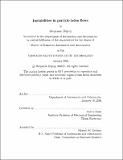Instabilities in particle-laden flows
Author(s)
Dupuy, Benjamin, 1981-
DownloadFull printable version (11.82Mb)
Other Contributors
Massachusetts Institute of Technology. Dept. of Aeronautics and Astronautics.
Advisor
Anette Hosoi.
Terms of use
Metadata
Show full item recordAbstract
Particles are present in many industrial processes and in nature. Dry granular flows and suspensions have been well studied and present a broad range of problems in terms of rheology and instabilities. In both cases, new phenomena are continually discovered. Indeed, complex behavior can be exhibited whether the granular media acts like a solid, a liquid or a gas. Moreover, the flow of thin liquid films on solid surfaces is a significant phenomenon in nature and in industrial processes (e.g. manufacture of computer chips, solar power cells, capacitors, etc.), where uniformity and completeness of wetting are paramount in importance. Two instabilities in particle-laden flows down an inclined plate are experimentally investigated and compared to theoretical predictions and scaling analysis. One of the fundamental coating flow geometries is the simple wetting of an inclined plane by a thin and uniform liquid film draining under gravity. It is well-known that, in a clear fluid, this leads to a fingering instability of the contact line. We perform experiments in this geometry using a mixture of silicone oil (1000 cSt) and heavy glass particles (d = 2.6) with a broad range of beads diameters, concentrations and angles. Small beads (106-212 [mu]m) do not present any new behavior since they are just convected by the flow and do not sediment fast enough to perturb it. A suspension with larger particles (250-425 ,[mu]m) exhibits different regimes depending on the angle and the concentration. For very high slopes and very dense suspensions a large ridge is formed at the contact line and does not break in regular fingers as observed previously. Quantitative measurements are performed using a laser sheet coupled (cont.) to a high-performance digital camera and compared to scaling analysis. A flow of suspension with no contact line may also be gravitationally instable. Shear-induced migration of particles can provoke an inversion of density which is the driving force of a Rayleigh-Taylor instability. Qualitative experimental results are compared to recent theories.
Description
Thesis (S.M.)--Massachusetts Institute of Technology, Dept. of Aeronautics and Astronautics, 2004. Includes bibliographical references (p. 85-90).
Date issued
2004Department
Massachusetts Institute of Technology. Department of Aeronautics and AstronauticsPublisher
Massachusetts Institute of Technology
Keywords
Aeronautics and Astronautics.